Spanish course-builder Santiago Varela has set a track of 14 beautifully decorated fences for tonight’s Tokyo Olympic team showjumping qualifier. The optimum time is 82 seconds.
Check out all the fences on the track for the Olympic team showjumping qualifier…
Fence 1: Logo of the Tokyo 2020 Olympics
Height: 1.55m
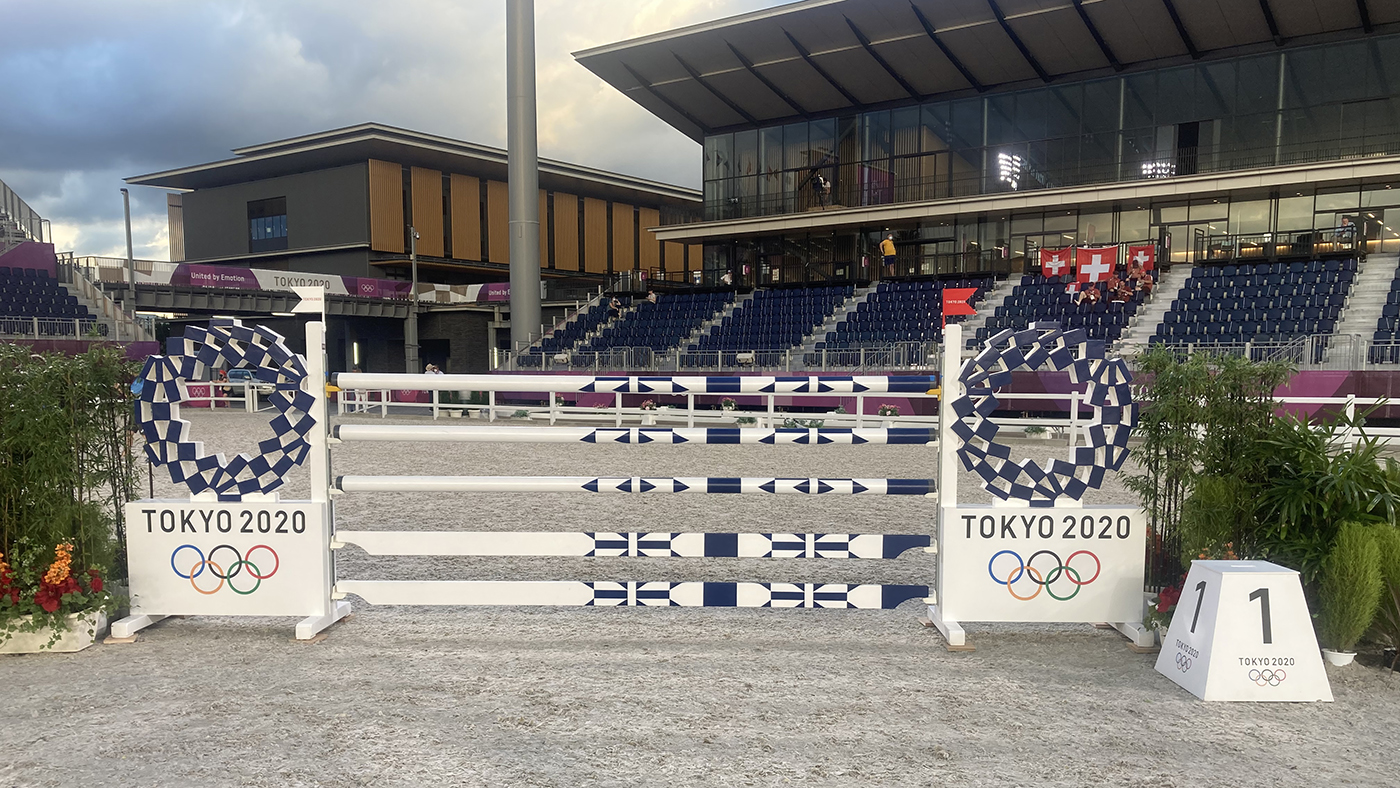
The harmonized chequered emblem, the logo for the 2020 Olympic Games, was produced by the Japanese designer Asao Tokoro. Composed of three varieties of rectangular shapes, the design represents different countries, cultures and ways of thinking. It incorporates the message of “unity in diversity”. It also expresses that the Olympic and Paralympic Games seek to promote diversity as a platform to connect the world.
After fence one there is a left-hand turn round the bottom of the arena, doubling back to fence two.
Fence 2: Himeji Castle
Front height: 1.52m
Back height: 1.53m
Spread: 1.60m

Himeji-jo is the finest surviving example of early 17th-century Japanese castle architecture. It is located in Himeji City, in the Hyogo Prefecture, an area that has been an important transportation hub in West Japan since ancient times. The castle has been designated a National Treasure and UNESCO World Heritage Site in 1993. The castle property, situated on a hill summit in the central part of the Harima Plain, covers 107 hectares and comprises eighty-two buildings. It is centred on the Tenshu-gun, a complex made up of the donjon, keeps and connecting structures ,which are part of a highly developed system of defence and ingenious protection devices dating from the beginning of the Shogun period. The castle worked continuously as the centre of a feudal domain for almost three centuries, until 1868 when the Shogun fell, and a new national government was created. The principal complex of these structures is a masterpiece of construction in wood, combining function with aesthetic appeal.
It is probably eight strides from fence two to the upright at fence three, a new fence for this evening.
Fence 3: Shinkansen High Speed Train
Height: 1.60m
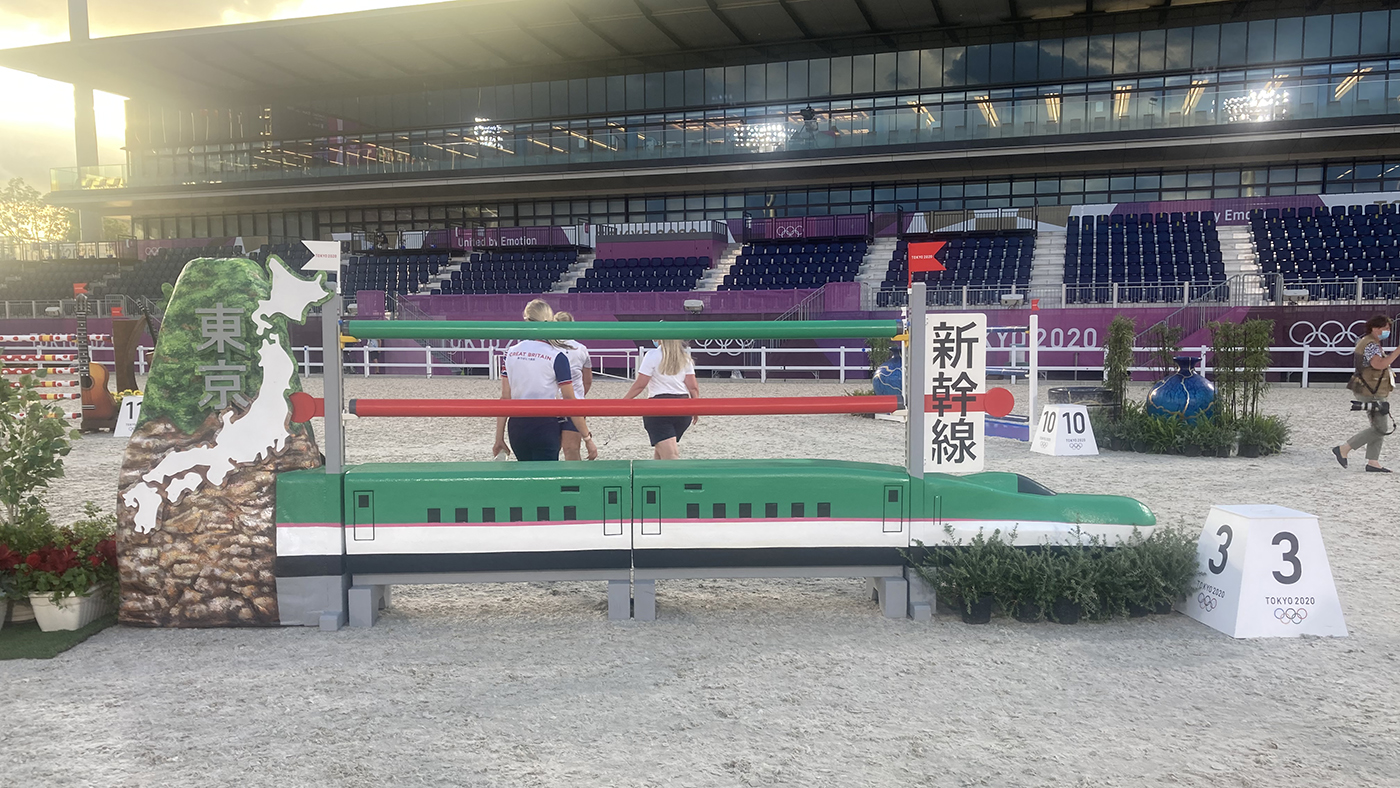
Before trains and railway systems arrived in Japan, one of the main routes in Japan was the Tokaido Route, which connects Kyoto (Capital of the Empire) and Osaka with Edo (Tokyo). As a tribute to the Olympic Games celebrated in 1964, Japan developed something new, the Sinkansen or Bullet Train. For the year 2020, a new train has been developed, with a more dynamic design and higher performance, known as Shinkansen Supreme. As previous bullet trains, its first trip will complete the route Tokaido-Shinkansen.
After fence three riders turn right around the water tray at fence 10 to get to fence four.
Fence 4: Good Luck Charm – Daruma
Front and back height: 1.53m
Spread: 1.65m
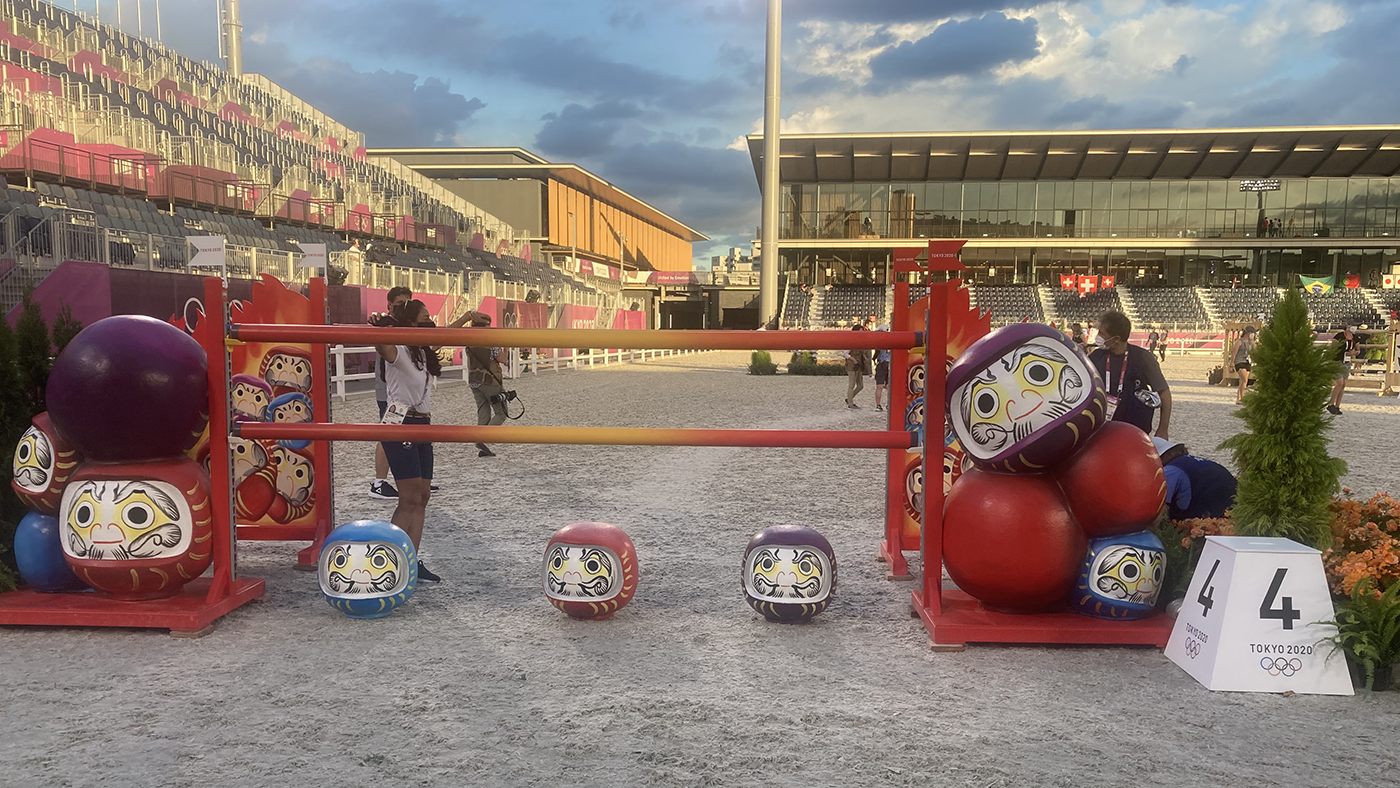
Every year, during the month of January (normally on 6th and 7th) more than 400,000 Japanese reach the temple in search of a daruma for the incoming year. The Daruma is considered a motivational amulet. It is considered to be motivational because it motivates us and gives us strength so that we can achieve what we propose. The daruma is a representation of the objective that we have self-imposed, a way to remember, a motivation, so that we do not feel weak during the process. Fall seven times, come back eight.
After fence four, there is a right-hand curve to fence five, on seven strides.
Fence 5abc: Japanese Calligraphy
Fence 5a front height: 85cm
Fence 5a back height: 1.57m
Fence 5a spread: 1.90m
Fence 5b height: 1.58m
Fence 5c front height: 1.53m
Fence 5c back height: 1.53m
Fence 5c spread: 1.60m
Horses will take two strides between element a and element b and then one from element b to element c.
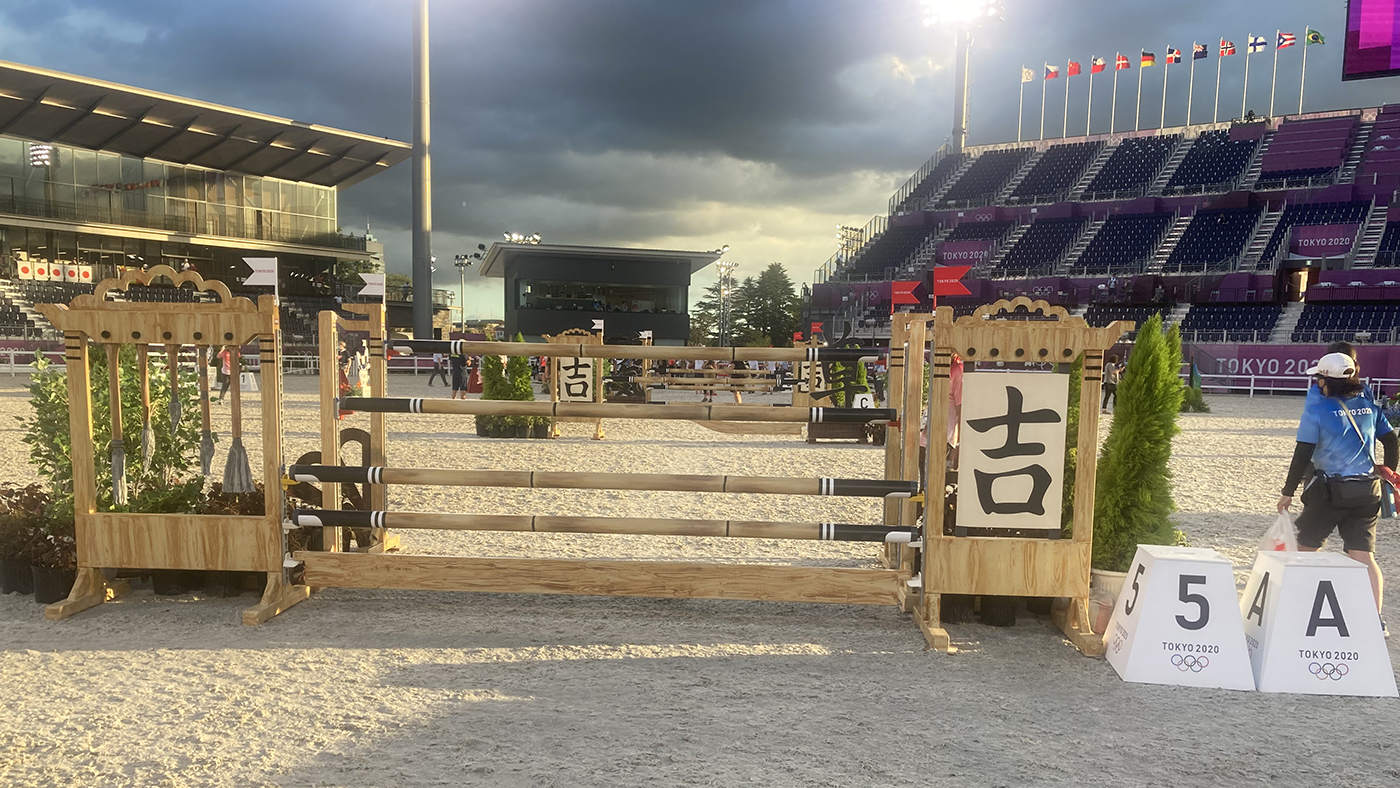
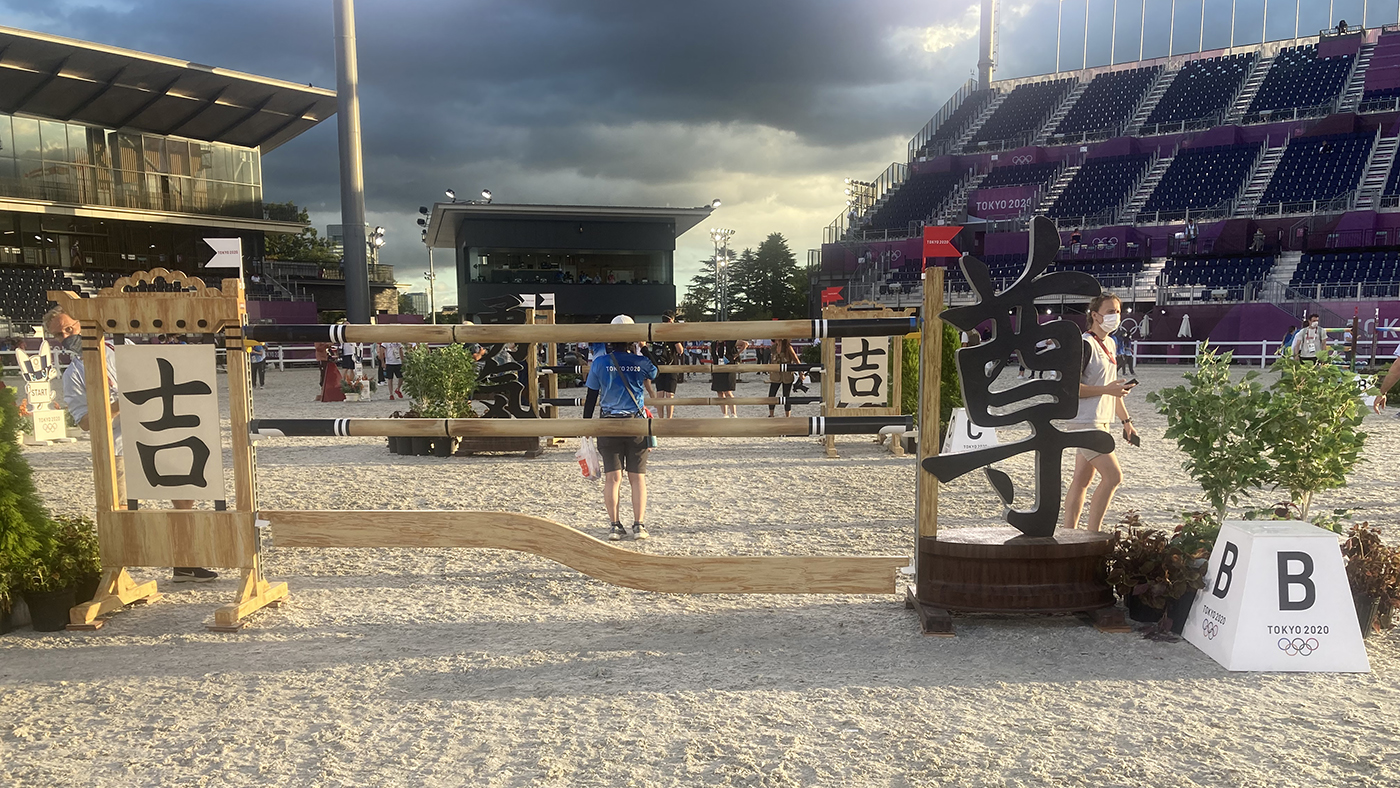

Japanese inherited their calligraphy tradition from a millenary Chinese tradition, which was introduced by Japanese Buddhist monks. Nowadays Japanese calligraphy is considered an art, and it is practiced making use of traditional tools which have been inherited from the Chinese tradition.
There are five strides from the treble combination to fence six, a fence we haven’t seen so far during the showjumping competition.
Fence 6: Samurais and Katanas
Height: 1.60m

Samurai were an elite military unit that controlled the country over centuries. Basic qualities of these soldiers consisted in loyalty, honour, audacity. Their life was really disciplined, and they was always a risk of death. The katana, daito in Japanese, was considered as the samurai’s soul. The original samurai armour was made out of iron sheets joined together by leather straps.
After this upright, it’s a left-hand turn back to fence seven, another new fence for this evening.
Fence 7: Shibuya Crossing, Tokyo
Height: 1.60m

Described as the busiest road intersection in the world (and definitely in Japan), Shibuya Crossing is like a giant beating heart, sending people in all directions with every pulsing light change. Hundreds of people – and at peak times reaching the estimated quantity of 3,000 people – cross at a time, coming from all directions at once, yet still managing to dodge each other with a practiced, nonchalant agility. It is located in Tokyo, the district that shares name with the city where we can find it, a popular commercial and leisure district.
There are four strides from the colourful wall to the spread at fence eight.
Fence 8: Farmhouses of Shirakawa
Front and back height: 1.53m
Spread: 1.65m
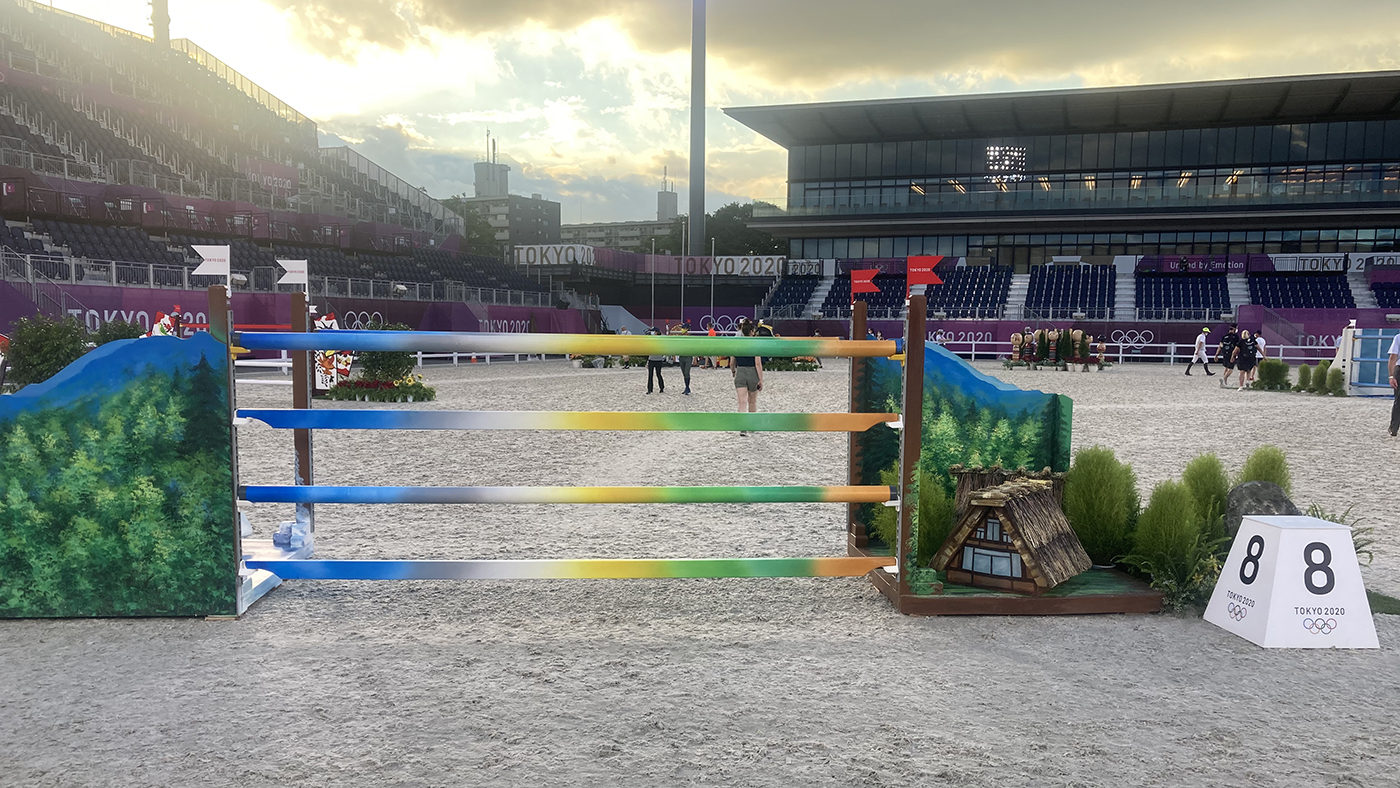
Shirakawago and Gokayama (五箇山), both neighbour villages, were declared by the UNESCO in 1995 as Patrimony of Humanity. Both are surrounded by mountains and are well known for their typical houses ,which were built following the gassho-zukuri style (合掌造り), which consists of houses with a triangular rooftop with a high inclination degree made out of hay so that it can handle the heavy weight that the snow can exert upon it.
Riders then turn right-handed to fence nine.
Fence 9: Port of Tokyo Tunnel (Tōkyō-kō Tunnel), Bayshore Route
Front and back height: 1.52m
Spread: 1.70m
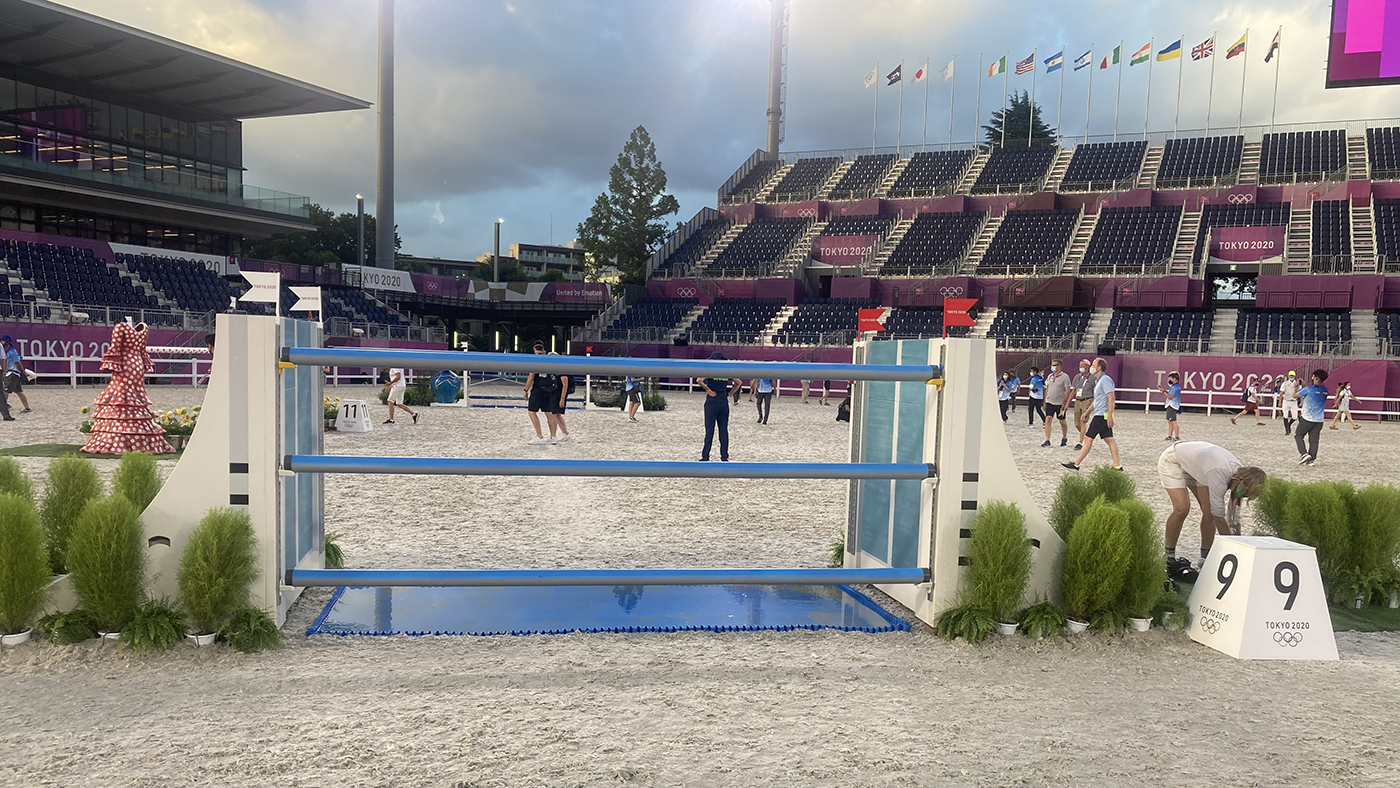
This immersed-tube tunnel beneath Tokyo Port was completed in 1976. It forms a crucial link in the Tokyo Port Metropolitan Expressway loop road that serves the Odaiba and Tokyo Bay waterfront areas. It is located on the Bayshore Route, the Tokyo metropolitan area expressway, which joins the prefectures of Kanagawa, Tokyo and Chiba. It joins the many artificial islands which compose Tokyo Bay throughout underwater bridges and tunnels. This route, along with the Aqua-line located in Tokyo Bay and the Ken-Ō Expressway, forms an outer ring around the metropolis (Tokyo), with a radius of 40-60 km and a length of about 300 km.
Horses will then take six strides down to fence 10.
Fence 10: Gold Repaired Broken Pottery
Height: 1.61m
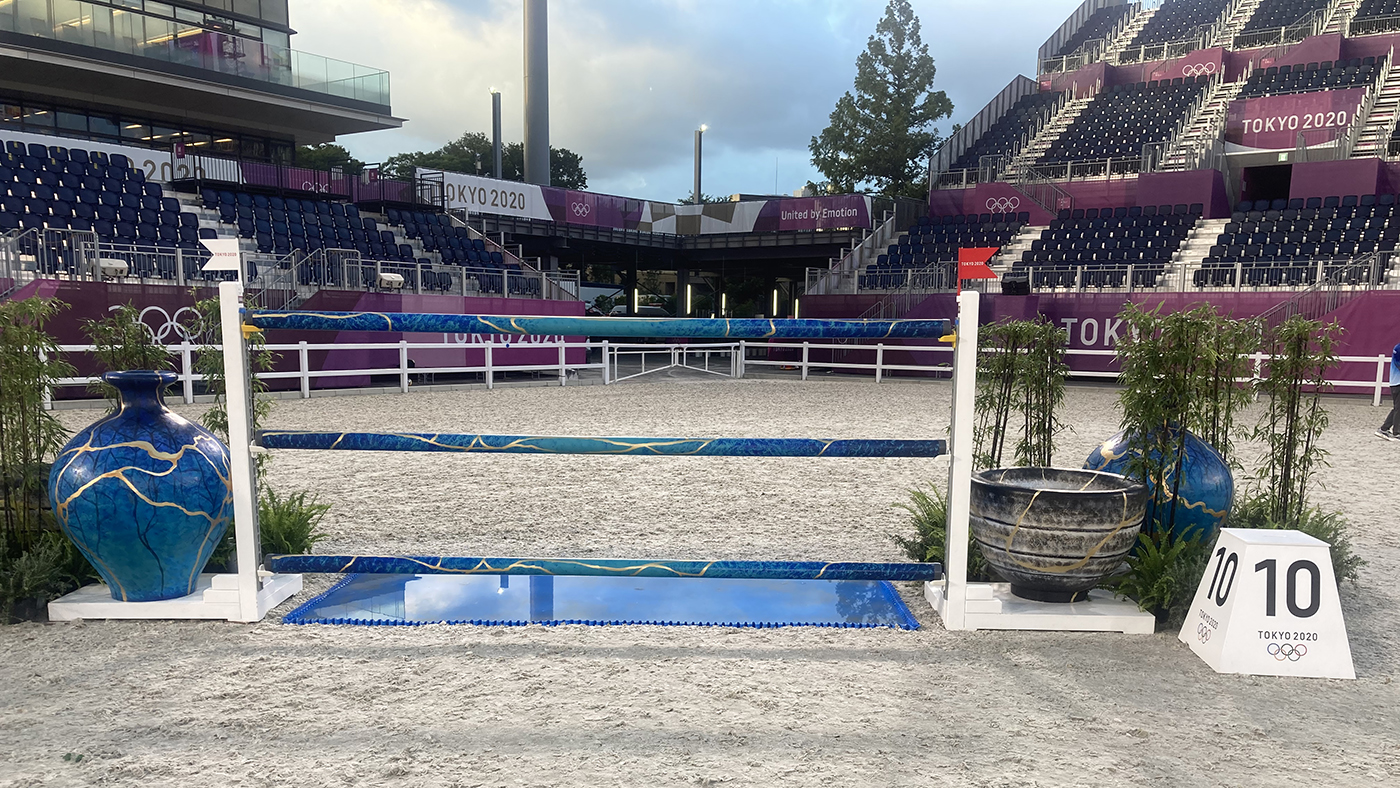
The “kintsugi” is a traditional technique used in Japan that dates of the second half of the 15th century. It gives a new life to the fragments of broken ceramics by joining them with a special enamel sprinkled with gold, silver or platinum, turning the different fractures into golden and visible scars. This turns its aesthetic essence into a more beautiful object than it was originally. It evokes the value of imperfection by making emphasis on its scars instead of concealing the lines of breakage, and by not hiding them, they become unique and more beautiful. It is one possible kind of life philosophy: when we are facing adversities and our errors, we must know how to recover, how to see the beauty in this imperfection (Japanese philosophy of Wabi-Sabi). We must also know how to lament only when we waste opportunities (the Mottainai sentiment), and most importantly, we must be able to accept changes.
Riders then turn right-handed and turn back round to fence 11.
Fence 11: Spanish Flamenco
Front and back height: 1.53m
Spread: 1.65m
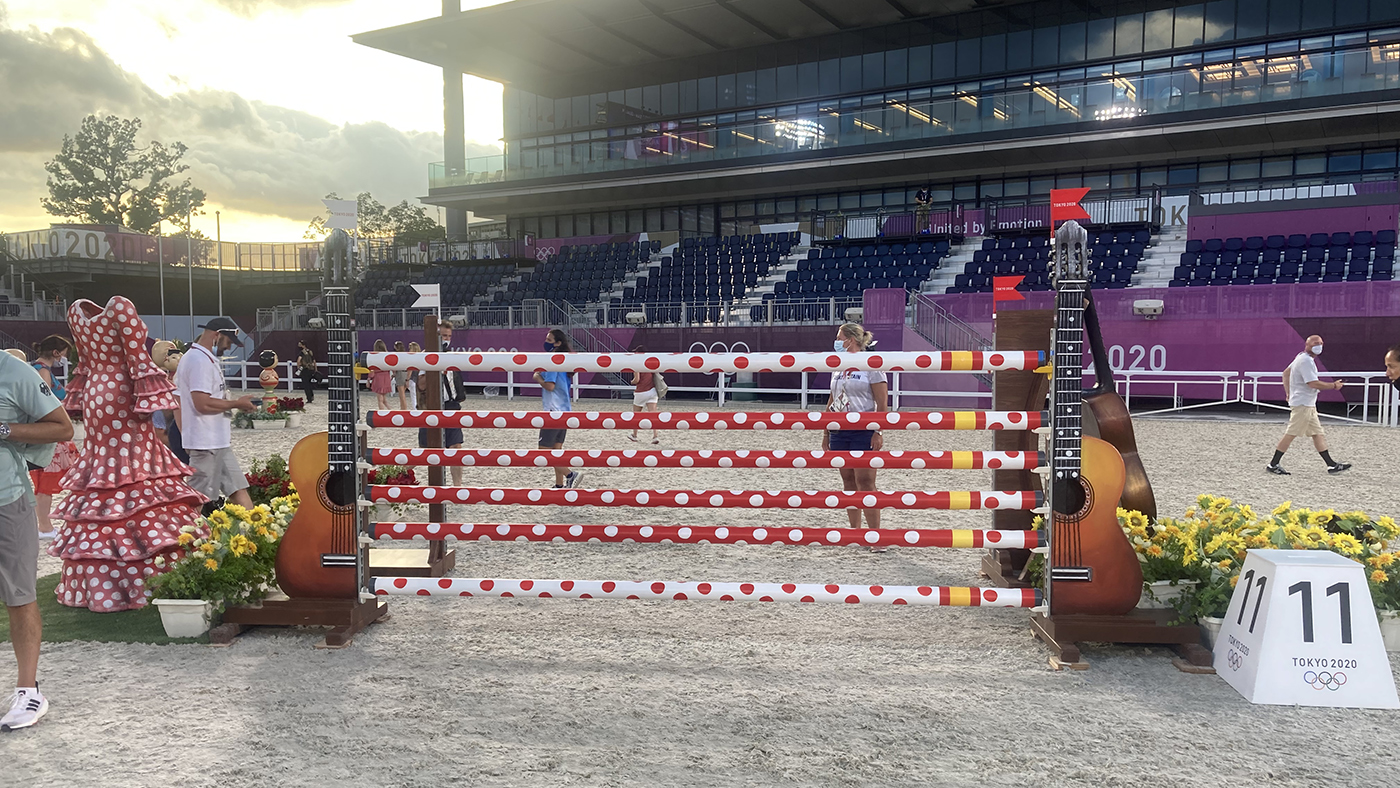
Flamenco is a perfect representation of the fusion of Japanese and Spanish culture. Out from all the countries throughout the world, Japan is the one where they best understand Spanish Flamenco. Both cultures share some similarities, and Flamenco is the best way to represent this idea. Flamenco has been conceived not to be understood, but to be felt, it is a really expressive art. This jump is in some way, a tribute to the course designer team’s country.
It’s then a left-hand turn to the final line.
Fence 12: Japanese Hairpins and Bow
Front and back height: 1.53m
Spread: 1.60m
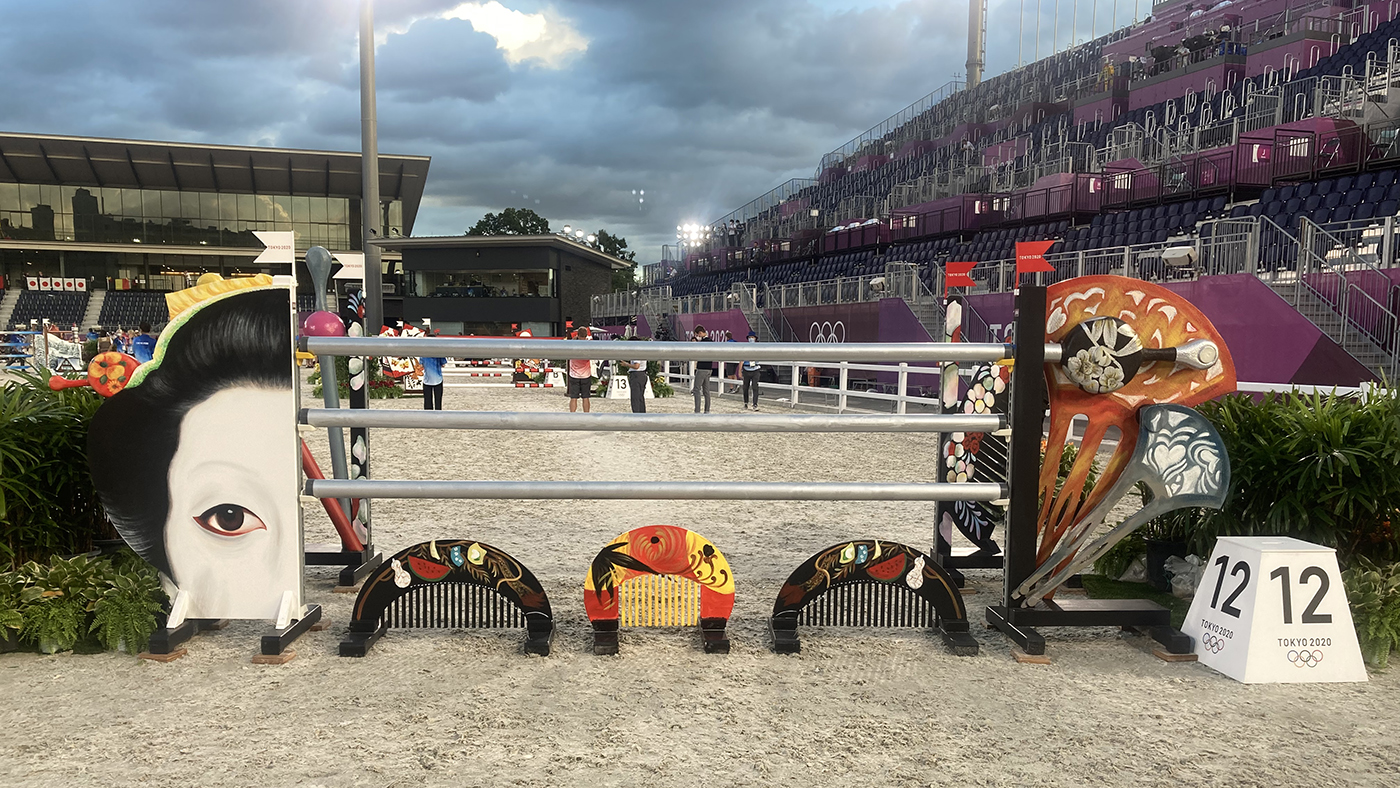
The Kanzashi (簪) are hair ornaments used in traditional Japanese hairstyles. They are fabricated from a wide range of materials such as lacquered wood, gold- and silver-plated metal, tortoiseshell and silk, and recently, plastic. Early bakelite kanzashi are highly valued as collectibles. There are several basic kanzashi styles that traditionally followed more complex hana (flower) and seasonal arrangements. Today these arrangements are only followed by maiko. Kanzashi were first used in Japan during the Jōmon period. During that time, a single thin rod or stick was considered to have mystical powers which could ward off evil spirits, so people would wear them in their hair. It came into wide use during the Edo period, when hairstyles became larger and more complicated, it required using a larger number of ornaments. Artisans began to produce more finely crafted products, including some hair ornaments that could be used as defensive weapons. During the latter part of the Edo period, the craftsmanship of kanzashi reached a high point, with many styles and designs being created.
The line to fence 13ab is on a slight left-hand curve, on five strides.
Fence 13ab: Hanafuda Playing Cards
Fence 13a height: 1.60m
Fence 13b height: 1.60m
There is one stride between elements of this double.
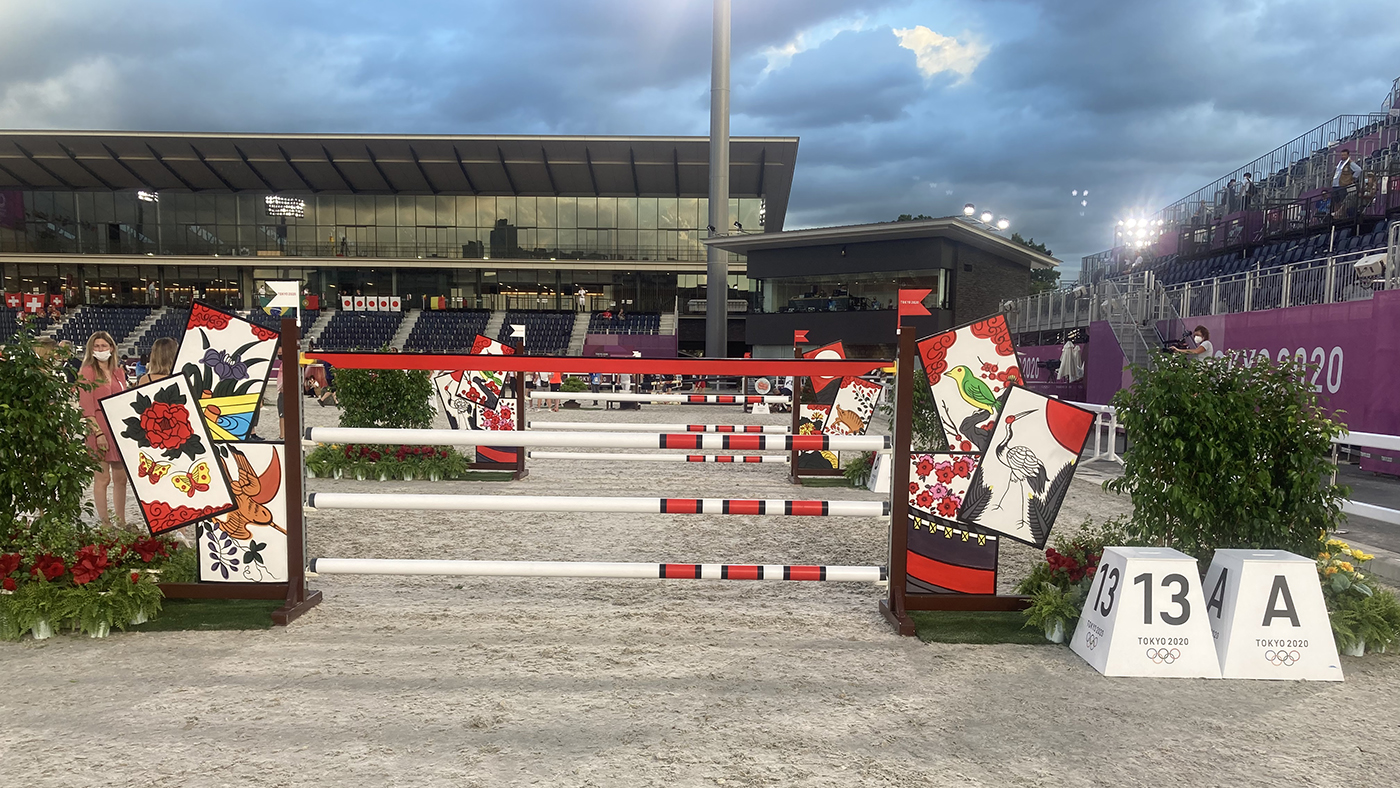
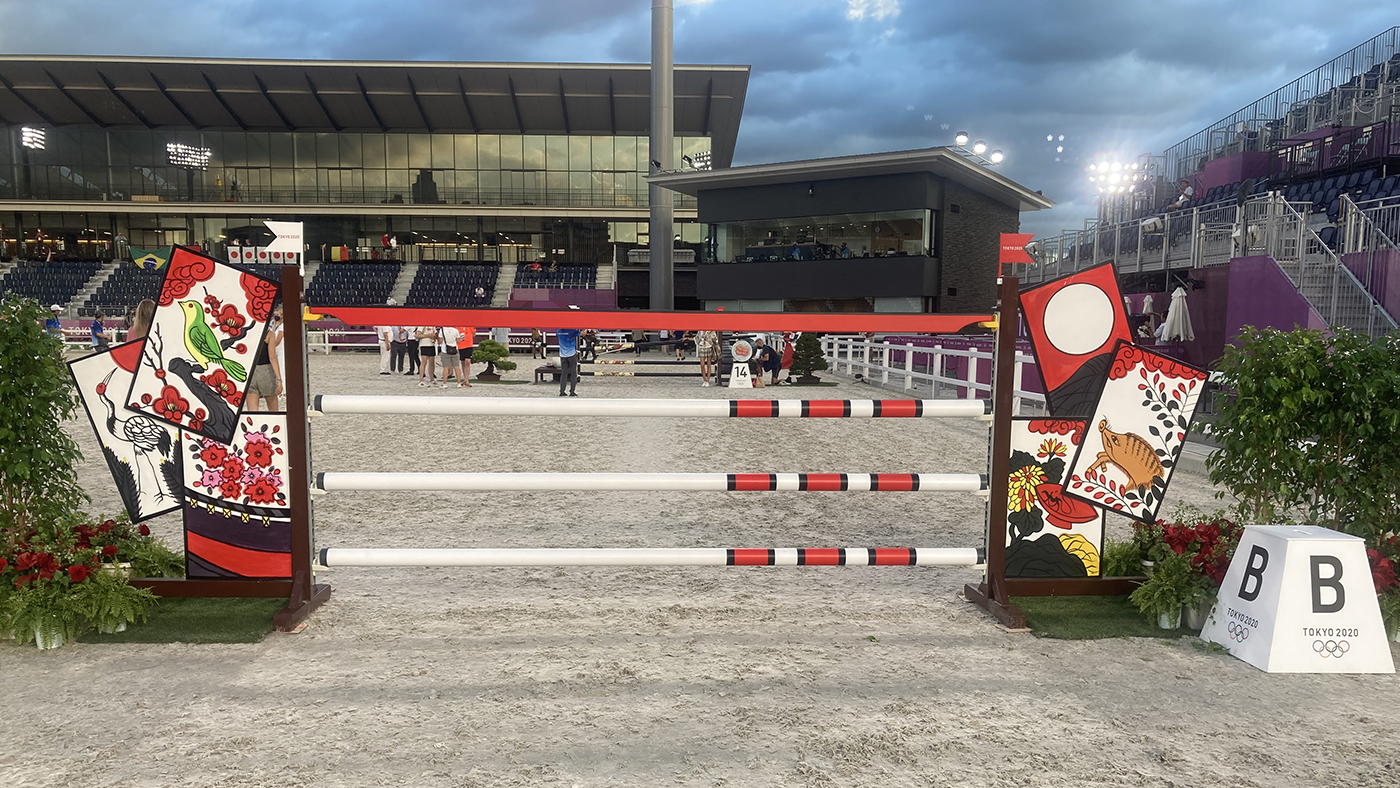
Hanafuda is a Karuta deck of cards that were invented halfway through the XVI century. Card games were forbidden throughout all Japan, so Japanese people searched for an alternative and they came out with Hanafuda, a card game where the card numbers were now represented by the twelve months of the year. Reaching the end of the XVIII century cards were legalised again and Fusajiro Yamamuchi, a card-game lover, was so delighted that he opened a company whose objective was to sell high-class cards, the company’s name was Nintendo.
It’s then five more strides down to the last fence.
Fence 14: Japanese Food
Front and back height: 1.53m
Spread: 1.70m
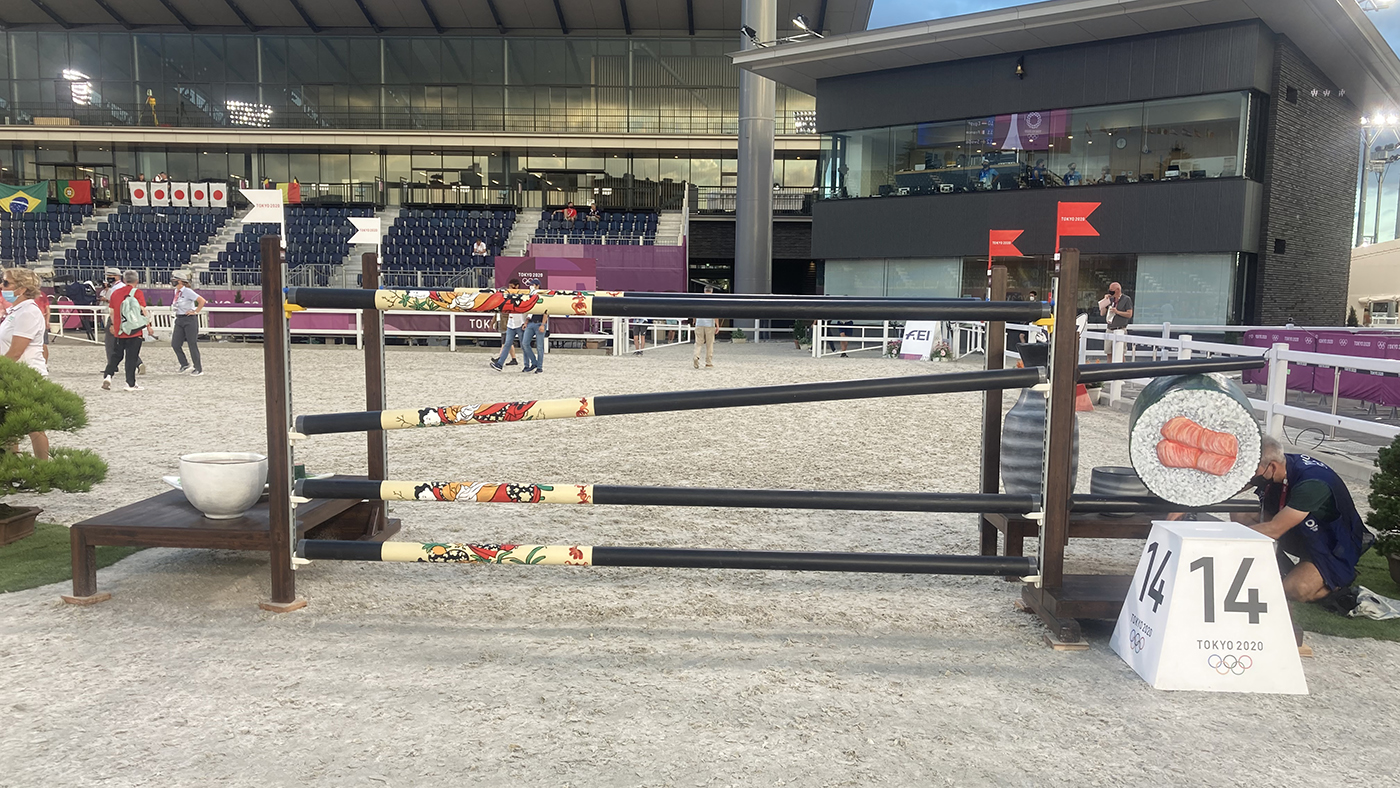
The Japanese understand gastronomy as an art. When cooking they always seek the harmony of all the ingredients and the presentation of these. Making sushi is a real spectacle in itself. Aesthetics always play an important role as they are a vital part when we are in search of this harmony. We begin to enjoy food through the sense of sight. Occasionally, on informal occasions soup and rice are eaten with some fish, shellfish and meat. When we prepare meals to be carried in the typical Bento boxes, it is common to include small portions of different types of food separated in different compartments. On more formal occasions, those “rules” that we follow when: presenting our dishes, choosing the food and the cooking of these; become much more stringent. One of the best-known set of rules is to use five colours: green, yellow, red, white and black; five flavours: sweet, salty, sour, hot & spicy and acid; and five kinds of cooking: raw, cooked, steamed, grilled/griddled and fried.
Tokyo Olympics team showjumping qualifier course plan

You might also be interested in:

How to watch Olympic showjumping live

Find out what time Britain’s showjumpers will start at the Olympics today – start list released for team qualifier

Daily weigh-ins and blood tests, 50 vets and a state-of-the-art facility: inside the Tokyo Olympics vet clinic

‘The team is still strong’: minor injury forces 11th hour switch to British Olympic showjumping team

Subscribe to Horse & Hound magazine today – and enjoy unlimited website access all year round
Horse & Hound magazine, out every Thursday, is packed with all the latest news and reports, as well as interviews, specials, nostalgia, vet and training advice. Find how you can enjoy the magazine delivered to your door every week, plus options to upgrade your subscription to access our online service that brings you breaking news and reports as well as other benefits.




